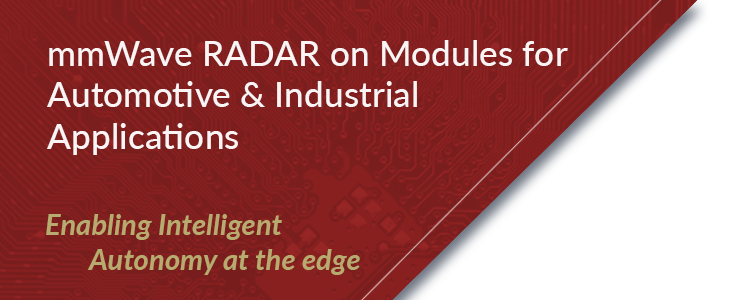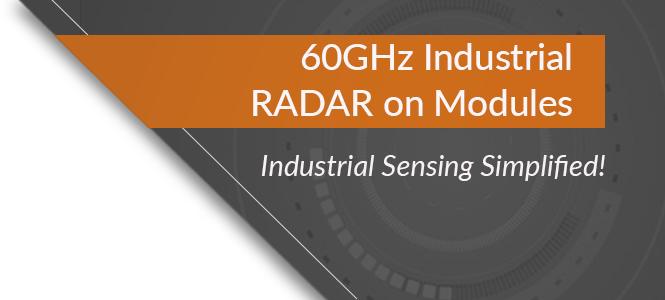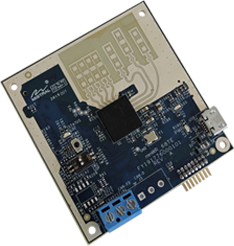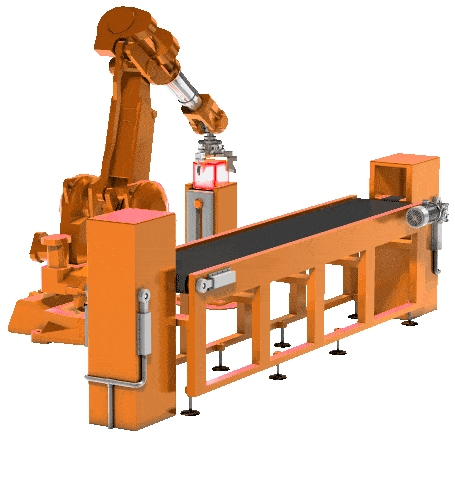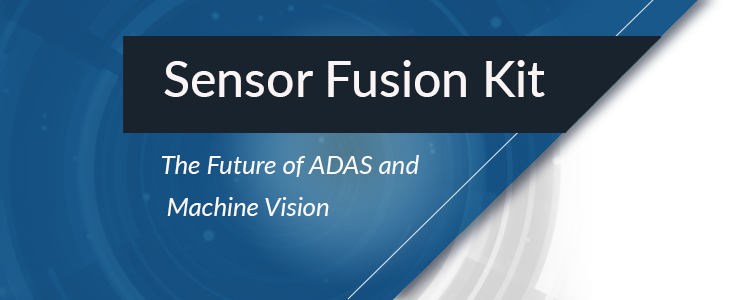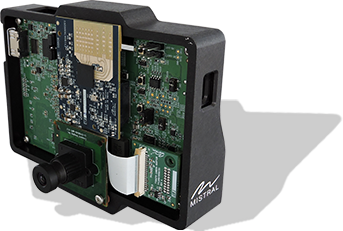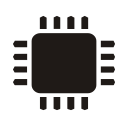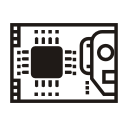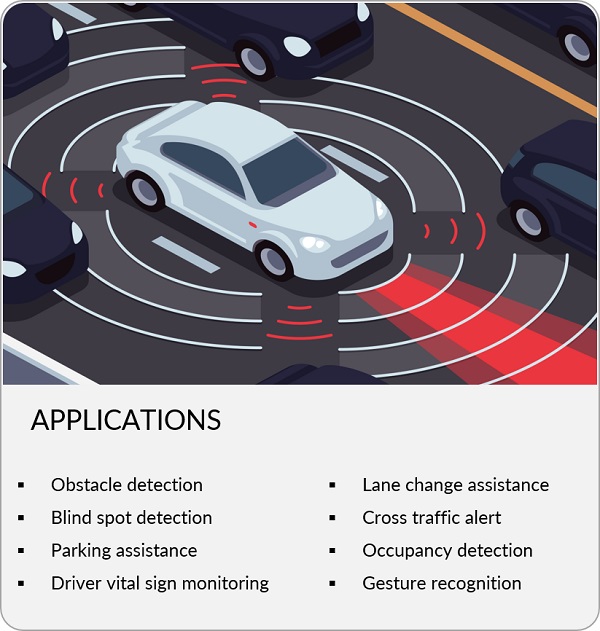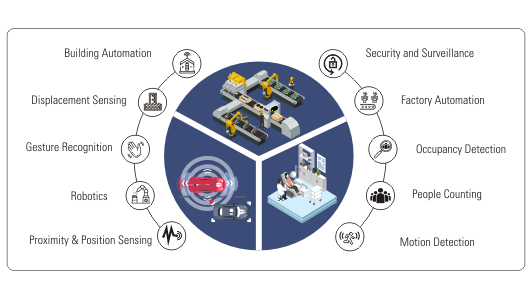mmWave RADAR Technology
mmWave RADAR Modules from Mistral are based on single-chip millimeter wave RADAR Technology from Texas Instruments – enabling intelligent and autonomous decision making at the edge! Based on the 77GHz and 60GHz TI mmWave RADAR Technology chipsets enabling Automotive, Machine Vision, Remote Sensing, Safety, Industrial and Smart City Applications.
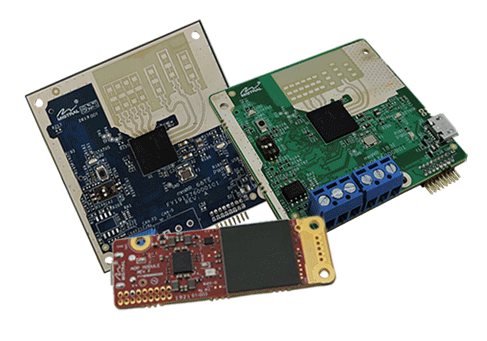
mmWave RADAR Technology
mmWave RADAR
The millimeter wave RADAR is an extremely valuable sensing mmWave RADAR Technology ideal for detection of objects and providing information on range, velocity and angle of these objects. The mmwave radar uses a contactless system which operates in the spectrum between 30GHz and 300GHz. mmWave RADAR (millimeter wave radar) has recently attracted significant interest regarding meeting the capacity requirements of the future 5G Wave networks. The mmWave Technology can be used in a broad range of products and services, such as high-speed, point-to-point wireless local area networks (WLANs) and broadband access.
Since mmWave Technology uses small wavelengths, it can provide sub-mm range accuracy and is able to penetrate materials such as plastic, drywall, clothing, and is impervious to environmental conditions like rain, fog, dust and snow. Mistral’s range of millimeter wave radar or mmWave Technology based RADAR solutions are based on Texas Instruments family of mmWave Technology, aka, AWR mmWave RADAR sensors for automotive and IWR millimeter wave radar sensors for industrial, drones and medical applications.
The diagrams below show the various Automotive and Industrial applications that the various mmWave Technology based RADAR Modules from Mistral can be used for.

60GHz Indl. AoPCB RoM
Overview:
The Industrial (60GHz) TI mmWave RADAR on Modules (RoM) with Antenna on PCB (AoPCB) from Mistral are easy to use, compact, light-weight TI mmWave RADAR based Modules providing high functionality for Industrial applications. Based on Texas Instruments IWR6843 ES2.0 ultra high-resolution single chip FMCW RADAR sensor SoC, the TI mmWave RADAR Modules for Industrial applications are ideal for low power, self-calibrating, ultra-accurate millimeter wave radar systems in industrial environment.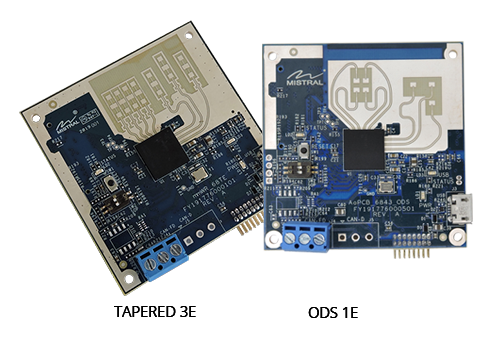
The Industrial millimeter wave radar Technology based RADAR modules operate at frequency bands of 60-64GHz. The modules are among the most powerful in its category currently in market and comes with advanced features such as FMCW Transceiver, DSP for Advanced Signal Processing, Hardware Accelerator (for FFT, Filtering, and CFAR Processing), ARM R4F Microcontroller, Built-in Calibration and Self-Test (address safety, aging and temperature-based variations). The millimeter wave radar modules include starter-ware and sample applications for common Industrial RADAR usages.
These standalone radar modules come with Tapered 3E or ODS 1E PCB antenna to cater to different industrial applications.
The millimeter wave radar modules support flexible industrial interfaces like USB, CAN, UART and SPI and can be powered via USB or Header. Complex signal processing runs within the mmWave RADAR Modules and only the processed Point Cloud RADAR data (Object’s ID, Range, Angle and Velocity) is given out over serial/CAN interfaces. In addition, raw data output is made available via LVDS ports, for debugging and development purpose. The Raw ADC data capture can also be enabled by pairing with TI’s DCA1000EVM real-time data capture adapter via the 60-pin Samtech connector. The mmWave Technology based Industrial RoMs (AoPCB) come with SDK 3.05, along with object detection and counting sample applications.
The small footprint of the TI mmWave RADAR modules ensures that customers can design custom enclosure for the mmWave RADAR modules to suit their application. Mistral can also build and provide custom IP6x compliant enclosures based on customer requirements.
Ordering Information for Tapered 3E Module
| Slab Qty | Lead time | Price | |
|---|---|---|---|
| 1-49 | 1-2 weeks | $149 |  |
| 50 + | 4-5 weeks | ||
| 100+ | 4-5 weeks | ||
| 500+ to 1K+ | 10-12 weeks |
For pricing information of ODS 1E Module, please contact sales@mistralsolutions.com
HIGHLIGHTS:
Small, Optimized,
Ready-to-use
Built-in Calibration
and Self-Test
USB
Powered
Flexible
Connectivity Option
60GHz AoPCB RoM Specs
Specifications:
The mmWave RADAR Technology based Industrial RADAR on Modules (AoPCB) is built around IWR6843 from Texas Instruments assuring long lifecycle and support. These millimeter wave radar modules are available in two antenna variants – 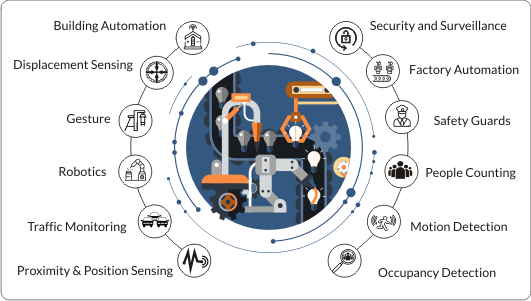 Tapered 3E and ODS 1E.
Tapered 3E and ODS 1E.
- mmWave RADAR
- FMCW Transceiver with Integrated PLL, Transmitter, Receiver, Baseband and ADC
- 60-64GHz Coverage with 4GHz Continuous Bandwidth
- Four Receive Channels and Three Transmit Channels
- Built-in Calibration and Self-test
- ARM® Cortex® R4F-Based Radio Control System
- Hardware Accelerator for Signal Processing (FFT, Filtering and CFAR Processing)
- C674x DSP for Advanced Signal Processing
- Antenna Pattern: Tapered 3E and ODS 1E
- Firmware Support
- Necessary Drivers, OSAL, mmWaveLink, mmWaveLib, mmWave API, Binary RADARSS Firmware
- Supports TI’s SDK 3.5
- Sample applications
- Obstacle detection out of box demo
- People counting
- Collision warning
- Vital signs monitoring
- Chirp configuration files for
- Ultra-Short Range, Short Range and Medium Range
- Peripherals Support
- CAN for external connectivity
- 1 SPI Channel, 1 UART, I2C, GPIOs Interface Support
- JTAG and 2-Lane LVDS Interface for Raw ADC Data and Debug (DCA1000)
- Power: 5V @ 1.2 A (max)
- Dimension (L x W x H) : 54 x 53 x 18 mm
- Weight: 15g
- Operating Temperature Range: -40O C to 85O C
77GHz Automotive RoM
Overview:
The 77GHz Automotive RADAR Modules (RoM) with Antenna on PCB (AoPCB) from Mistral is an easy to use, compact, light-weight RADAR based on mmWave Technology that provides superior functionalities for ADAS applications. Based on Texas Instruments AWR1843 ES2.0 ultra-high-resolution single chip FMCW RADAR sensor SoC, the Automotive mmWave RADAR Technology Modules are best suited for low power, self-calibrating, ultra-accurate RADAR systems in automotive environment.
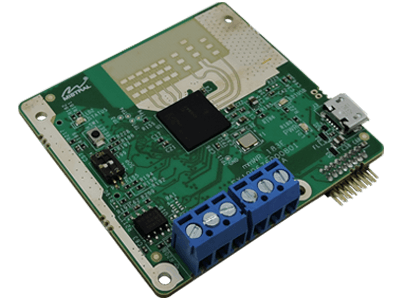 The mmWave RADAR based Automotive RoM operates at frequency bands of 76-81GHz and is expected to one of the most powerful in its category currently in market. The module comes with advanced features such as FMCW Transceiver, DSP for advanced signal processing, Hardware Accelerator for FFT, Filtering, and CFAR processing, ARM R4F Microcontroller, built-in calibration and self-test, which will address safety, aging and temperature-based variations. The millimeter wave radar modules includes starterware and a sample application for common RADAR usage.
The mmWave RADAR based Automotive RoM operates at frequency bands of 76-81GHz and is expected to one of the most powerful in its category currently in market. The module comes with advanced features such as FMCW Transceiver, DSP for advanced signal processing, Hardware Accelerator for FFT, Filtering, and CFAR processing, ARM R4F Microcontroller, built-in calibration and self-test, which will address safety, aging and temperature-based variations. The millimeter wave radar modules includes starterware and a sample application for common RADAR usage.
The standalone mmwave RADAR module comes with Three Element (3E) PCB antenna. The module supports all key automotive interfaces such as CAN, CAN-FD, USB, UART & SPI and can be powered via USB or Header.
The in-built C674xDSP aids complex signal processing and the processed point cloud RADAR data such as Target ID, Range, Angle and Velocity are given out over serial/CAN interfaces. In addition, raw data output is made available via LVDS ports, for debugging and development purpose. The automotive AoPCB module comes with SDK 3.5, along with object detection sample application.
Mistral’s 77GHz Automotive RADAR on Module is ideal for applications such as obstacle detection, blind spot detection, parking assistance, driver vital sign monitoring, lane change assistance, cross-traffic alert, vehicle occupancy detection, gesture recognition, automatic cruise control and collision warning.
HIGHLIGHTS:
USB Powered
DSP for Advanced Signal Processing
Built-in Calibration and Self-Test
Standalone small footprint
77GHz RoM Specs
Specification:
Built around AWR1843 ES2.0 FMCW Sensor chip from Texas Instruments, the 77GHz Automotive mmWave RADAR on Module assures long lifecycle and product support.
- mmWave RADAR Technology
- FMCW Transceiver with integrated PLL, transmitter, receiver, baseband and ADC
- 76-81GHz coverage with 4GHz available bandwidth
- Four receive channels and three transmit channels
- Built-in calibration and self-test
- ARM® Cortex® R4F-based radio control system
- Hardware accelerator for signal processing (FFT, Filtering, and CFAR Processing)
- C674x DSP for FMCW signal processing
- Antenna Pattern: Three Elements
- Firmware Support
- Necessary Drivers, OSAL, mmWaveLink, mmWaveLib, mmWave API, Binary RADARSS Firmware
- Supports TI’s SDK 3.5
- Sample applications
- Obstacle detection out of box demo
- Chirp configuration files
- Peripherals Support
- CAN, CAN-FD for external connectivity
- 1 SPI Channels, 2 UARTs, I2C, GPIOs interface support
- JTAG and 2-lane LVDS Interface for raw ADC data and debug (DCA1000)
- Power: 5V @ 1.2 A (max)
- Dimension (LxWxH): 53 x 47.8 x 18 mm
- Operating Temperature Range: -40oC to 105oC
60GHz Indl. AoP RoM
Overview:
The 60GHz Industrial millimeter wave RADAR (mmWave RADAR Module) with Antenna on Package from Mistral is a low cost, ultra-compact, light-weight and easy to use module catering to wide range of industrial applications. Based on Texas Instruments IWR6843AoP ES2.0, an ultra-high-resolution single chip FMCW mmWave RADAR sensor, AoP mmWave RADAR on Module is ideal for low power, self-monitored, ultra-accurate mmWave RADAR systems in industrial environment.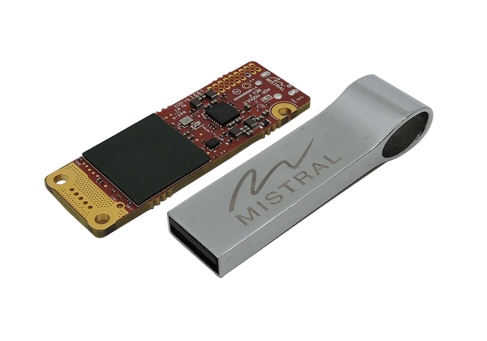
The highlight of the mmWave RADAR module is the IWR6843AoP ES2.0 Chipset, which comes with Integrated Antenna on Package, reducing RF PCB design challenges, product cost and footprint drastically.
The 60GHz AoP mmWave RADAR on Module operates at frequency bands of 60-64GHz. Currently, the module is one of the most powerful and highly integrated in Industrial mmWave RADAR market. The module comes with advanced features such as FMCW Transceiver, DSP for Advanced Signal Processing, Hardware Accelerator (for FFT, Filtering, and CFAR Processing), ARM R4F Microcontroller, Built-in Calibration and Self-test in a compact form factor (46.25 X 15.76 mm).
The mmWave RADAR module is powered via USB in standalone mode and delivers processed point cloud RADAR data [Target ID, Range, Angle and Velocity]. The Module supports interfaces like USB, SPI/CAN, UART & GPIOs. The AoP mmWave RADAR module comes with SDK 3.5 along with object detection and people counting sample applications. The mmWave RADAR on Module comes with a robust Mechanical enclosure that facilitates easy mounting to end product.
As the AoP RADAR on Module is built around IWR6843AoP ES2.0 from Texas Instrument, this assures long lifecycle and support. Mistral adds value by supplying pre-certified AoP RADAR on Modules which helps customer to accelerate time to market, reduces certification risks and seamless product integration.
HIGHLIGHTS:
Integrated Antenna on Package with FMCW Transceiver
Built-in Calibration
and Self-Test
USB
Powered
Ultra-Compact form factor
of 43.9 x 15.6 mm
60GHz AoP RoM Specs
Specification:
- Integrated Antenna on Package (AoP)
- FMCW Transceiver with Integrated PLL, Transmitter, Receiver, Baseband and ADC
- 60-64GHz Coverage With 4 GHz continuous Bandwidth
- Built-in Calibration and Self-Test
- ARM® Cortex® R4F-Based Radio Control System for Object Detection and Interface control
- C674x DSP for Advanced Signal Processing
- Three Transmit Channels and Four Receive Channels
- Max sampling rate: 25MSPS
- Hardware Accelerator for FFT, Filtering, and CFAR Processing
- Host Connectivity: 2 x UART / UART over USB
- USB Powered, 5V, 500mA – 1A
- Dimensions (LxWxH): 43.9 x 15.6 x 5 mm
Operating Temperature Range: -40oC to 85oC
AI-enabled Sensor Fusion
Overview:
The NVIDIA Jetson SoM based AI-enabled Sensor Fusion Kit (AI-SFK) from Mistral is an integrated, performance oriented, Camera Vision and mmWave RADAR fusion platform that meet the compelling needs of modern AI, Deep Learning, and Video Analytics applications.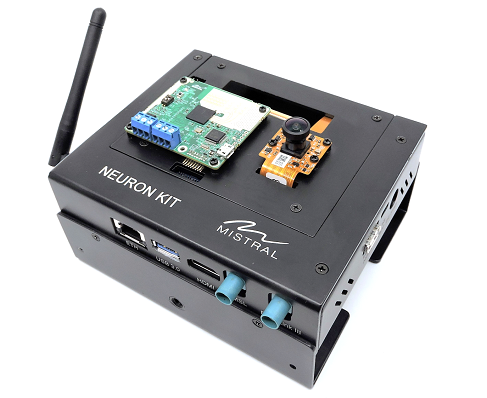
The AI-SFK (Camera Vision + mmWave RADAR) is uniquely designed to provide range precision along with superior imaging capabilities for applications such as ADAS, autonomous vehicle, smart retail, industrial 4.0, robotics, smart building, and smart city among others. The camera & mmWave RADAR complement each other for object detection, classification, range, velocity and elevation parameters. The platform provides vision analytics and RADAR data fusion in real-time.
The Kit consists of:
- Mistral’s Neuron Base Board (NB-Turbo) mated with NVIDIA Jetson Xavier NX SoM
- Performs object detection, classification and annotates video stream with RADAR range data
- Mistral’s 77GHz mmWave RADAR Module
- Consists of FMCW transceiver with integrated PLL, Baseband ADC, R4F controller with accelerator, SPI flash, DSP, etc.
- Camera Module
- CSI-based 8 MP / 4K colour sensor supporting up to 21 fps
The platform delivers RADAR point cloud and video data:
- The RADAR point cloud data consists of range, angle, velocity and signal strength
- Camera stream inferenced using NVIDIA’s Jetson-inference module & Tensor-RT and annotated for different types of objects
- Mistral’s Sensor fusion demo algorithm co-relates and combines RADAR target with pre-trained objects (humans)
The SFK also supports NVIDIA JetPack SDK, which enables the development of AI applications with accelerated libraries supporting all major AI frameworks as well as computer vision, graphics and multimedia among others.
Customization
In addition to providing engineering services for product/system development, Mistral provides customization services around SFK for:
- Custom camera integration
- Other sensor integration like thermal, LiDAR etc
- Application software
- ML/DL algorithms development and integration
- Remote firmware upgrade
- Audio and video
- Cloud and mobile apps
- PoE
- Power optimization
- Mechanical enclosure customization
- FCC/CE certification support
- Chirp Profile Tuning support
HIGHLIGHTS:
Scalable
Platform
Radar and Camera
Sensor Fusion
mmWave Radar
Interface
Flexible
Connectivity
DSP and
Large Memory
Fusion
Vision Analytics
AI-SFK Specs
Specification:
Jetson Xavier SoM
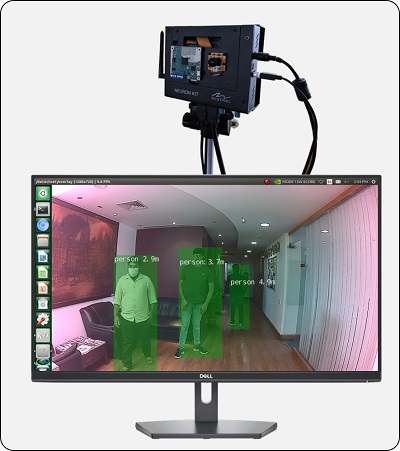
- 384-Core NVIDIA Volta GPU with 48 Tensor Cores
- 6-Core NVIDIA Carmel ARM v8.2 64-bit CPU
- 2x NVIDIA Engines
- 7-Way VLIW Vision Processor
- 8 GB 128-bit LPDDR4x
- 16 GB eMMC 5.1
- 10/100/1000 Base-T Ethernet
Camera Module
- CSI2-2 Lane Camera Interface
- Sony’s iMX219 from Leopard Imaging
mmWave RADAR
- Mistral’s 77GHz AoPCB RADAR module based on TI’s AWR1843 SoC
- FMCW Transceiver with Integrated PLL, Transmitter, Receiver, Baseband and ADC
- 76 to 81GHz Coverage with 4GHz available Bandwidth
- Four Receive Channels and Three Transmit Channels
- C674x DSP for FMCW Signal Processing
- ARM Cortex R4FBased Radio Control System for Object Tracking and Classification
Storage
- M.2 M key based 250GB SSD
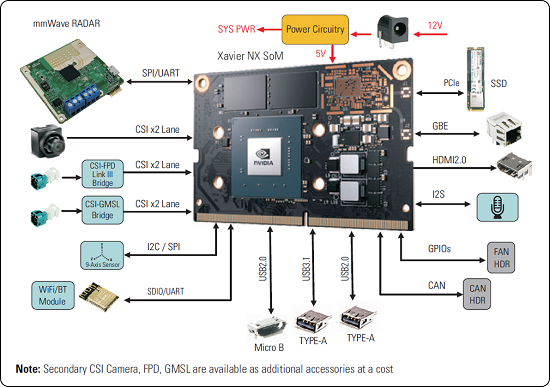
Network Connectivity
- Gigabit Ethernet
- Wi-Fi 802.11 a/b/g/n/ac
- BT 5.0
Other Interfaces
- Camera
- USB
- 1 x CSI2 – 2 Lanes
- 1x FPD Link III
- 1x GMSL
- USB
- 2x USB 2.0
- 1x USB 3.1
- Display
- HDMI 2.0
- Audio
- HDMI 2.0
- DMIC / I2S via Expansion Header
- CAN
- 9-axis IMU Sensor
- Expansion Header
- I2C, I2S, GPIOs, Reset
- Cooling: Active cooling with Fan
- Power: 12V/5A to 24V/2.5A
- Operating Temperature Range: -25 C to 80 C
AI-SFK Lite
Overview
The NVIDIA Jetson SoM based AI-enabled Sensor Fusion Kit Lite (AI-SFK Lite) from Mistral is an integrated, performance oriented, Camera Vision and mmWave RADAR fusion platform that meet the compelling needs of modern AI, Deep Learning, and Video Analytics applications.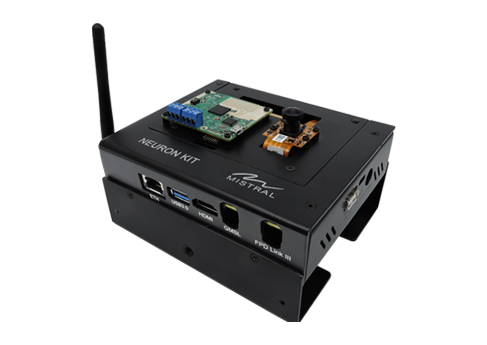
The AI-SFK Lite (Camera Vision + mmWave RADAR) is uniquely designed to provide range precision along with superior imaging capabilities for applications such as ADAS, autonomous vehicle, smart retail, industrial 4.0, robotics, smart building, and smart city among others. The camera & mmWave RADAR complement each other for object detection, classification, range, velocity and elevation parameters. The platform provides vision analytics and RADAR data fusion in real-time.
The AI-SFK Lite Kit consists of:
- Mistral’s Neuron Base Board (NB-Basic) mated with NVIDIA Jetson Xavier NX SoM
- Performs object detection, classification and annotates video stream with RADAR range data
- Mistral’s 77GHz mmWave RADAR Module
- Consists of FMCW transceiver with integrated PLL, Baseband ADC, R4F controller with accelerator, SPI flash, DSP, etc.
- Camera Module
- CSI-based 8 MP / 4K colour sensor supporting up to 21 fps
The platform delivers RADAR point cloud and video data:
- The RADAR point cloud data consists of range, angle, velocity and signal strength
- Camera stream inferenced using NVIDIA’s Jetson-inference module & Tensor-RT and annotated for different types of objects
- Mistral’s Sensor fusion demo algorithm co-relates and combines RADAR target with pre-trained objects (humans)
The AI-SFK Lite also supports NVIDIA JetPack SDK, which enables the development of AI applications with accelerated libraries supporting all major AI frameworks as well as computer vision, graphics and multimedia among others.
Customization
In addition to providing engineering services for product/system development, Mistral provides customization services around SFK Lite for:
- Custom camera integration
- Other sensor integration like thermal, LiDAR etc
- Application software
- ML/DL algorithms development and integration
- Remote firmware upgrade
- Audio and video
- Cloud and mobile apps
- PoE
- Power optimization
- Mechanical enclosure customization
- FCC/CE certification support
- Chirp Profile Tuning support
- AI-SFK Lite with 60GHz RADAR module
HIGHLIGHTS:
Scalable
Platform
Radar and Camera
Sensor Fusion
mmWave Radar
Interface
Flexible
Connectivity
DSP and
Large Memory
Fusion
Vision Analytics
AI-SFK Lite Specs
Specification:
Jetson Xavier SoM

- 384-Core NVIDIA Volta GPU with 48 Tensor Cores
- 6-Core NVIDIA Carmel ARM v8.2 64-bit CPU
- 2x NVIDIA Engines
- 7-Way VLIW Vision Processor
- 8 GB 128-bit LPDDR4x
- 16 GB eMMC 5.1
- 10/100/1000 Base-T Ethernet
Camera Module
- CSI2-2 Lane Camera Interface
- Sony’s iMX219 from Leopard Imaging
mmWave RADAR
- Mistral’s 77GHz AoPCB RADAR module based on TI’s AWR1843 SoC
- FMCW Transceiver with Integrated PLL, Transmitter, Receiver, Baseband and ADC
- 76 to 81GHz Coverage with 4GHz available Bandwidth
- Four Receive Channels and Three Transmit Channels
- C674x DSP for FMCW Signal Processing
- ARM Cortex R4FBased Radio Control System for Object Tracking and Classification
Storage
- M.2 M key based 250GB SSD
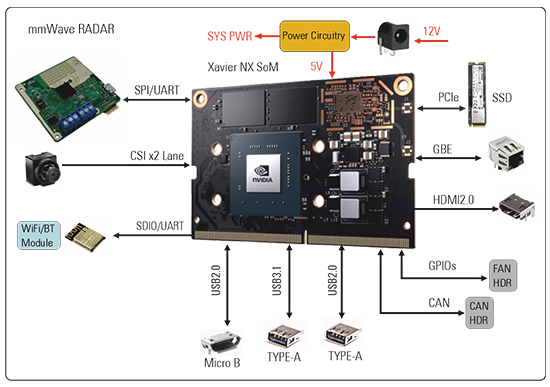
Network Connectivity
- Gigabit Ethernet
- Wi-Fi 802.11 a/b/g/n/ac
- BT 5.0
Other Interfaces
- Camera
- USB
- 1 x CSI2 – 2 Lanes
- USB
- 2x USB 2.0
- 1x USB 3.1
- Display
- HDMI 2.0
- Audio
- HDMI 2.0
- I2S via Expansion Header
- CAN
- Expansion Header
- I2C, I2S, GPIOs, Reset
- Cooling: Active cooling with Fan
- Power: 12V/5A to 24V/2.5A
- Operating Temperature Range: -25 C to 80 C
mmWave Software IPs
mmWave Software IPs
Mistral offers three optional software IPs for the mmWave RADARs that can support and accelerate product development lifecycle. Each of these Software IPs needs to be bought separately and are NOT part of standard module deliverables. For pricing, please contact us at sales@mistralsolutions.com
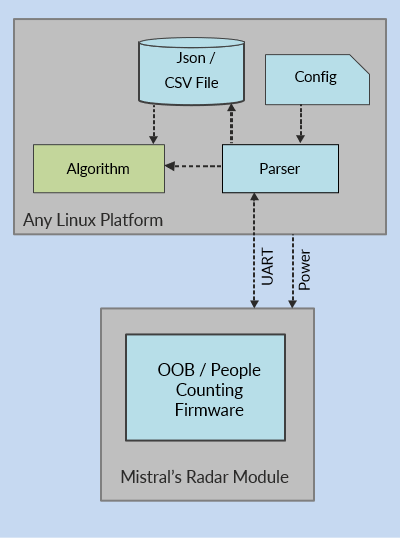
Host Parser Application
Host Parser helps product developers to parse the point cloud data received from the RADAR and makes it available as an API.
- Runs on: Linux Ubuntu machines, Windows 10 (WIP)
- Python 3 implementation
- Consists of:
- Base library and Parser with documented API
- Does Real-time capture of Point cloud data and range profile TLVs
- Supports 5 to 20 frames per second
- Sample application (using the above library)
- Connects and sends configuration file to the RADAR on start-up
- Saves the Point cloud data in CSV or text file
- Supports TI mmWave SDK 3.5.0.4 and out of box demo
- Works with xWR1843, xWR6843 and xWR6843AoP Radar modules
- Deliverables: Python scripts, API document and User guide
- Base library and Parser with documented API
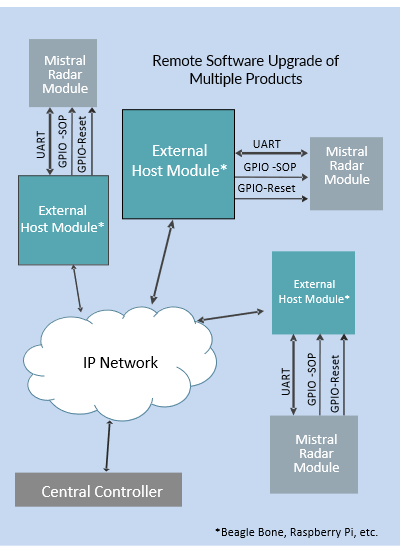
Remote Firmware Upgrade
Remote Firmware Upgrade enables OEMs to upgrade the RADAR firmware remotely over UART interface for commercially deployed products.
- Runs on Linux Host machines
- Python 2/3 implementation
- Based on modified TI mmWave SDK 3.5.04.
- For failure Protection comprises of
- Default factory copy and working copy of firmware
- Working copy is upgradable
- CRC based firmware health check
- Works with IWR1843, IWR6843 and IWR6843AoP Radar modules
- Deliverables: Python scripts, Secondary bootloader binary, firmware binaries, TI mmWave SDK patches, build guide and user guide
Note: Requires few HW changes for older modules. Documented.
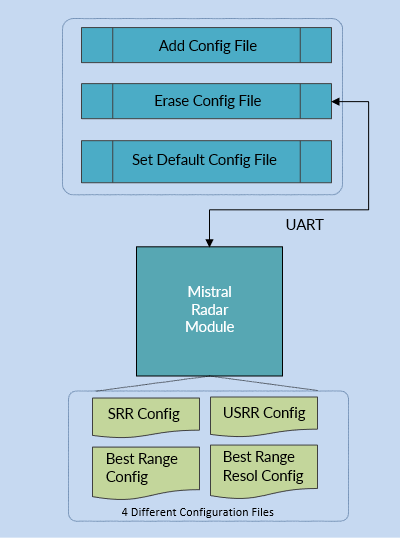
Multi Configuration Management
Helps load and store up to five RADAR configurations and manage them remotely during both development and after deployment. One of the configurations can be set to Autoload on Power-on enabling instant streaming of point cloud data.
- Runs on Linux Host machines
- Python2/3 implementation
- Based on modified TI mmWave SDK 3.5.04.
- Remotely managed over UART interface
- Capability to save up to 5 configuration parameter set files and to define one of them as Default
- Auto load of default configuration parameters during radar module boot.
- Does not required loading of configuration parameters from the host.
- Works with IWR1843, IWR6843 and IWR6843AoP Radar modules
- Deliverables: Python scripts, firmware binaries, TI mmWave SDK patches, build guide and user guide
Frequently Asked Questions
Antenna
Q. What is the Antenna Type on the mmWave RADAR Modules?
A. 77GHz and 60GHz AoPCB: By default, 3 Element antenna type is available.
We can also provide ODS or custom antenna for specific application based on volume requirement.
60GHz AoP: ODS Antenna Pattern
FOV
Q. What is the Azimuth FOV of mmWave RADAR Modules?
A. 60GHz AoP: +/- 60⁰
60GHz AoPCB: at 2m 150° ; at 3m 130° ; at 5m 110° ; at 8m 90° ; at 20m 80° ; at 50m 40°
77GHz AoPCB: at 2m 150° ; at 3m 130° ; at 5m 120° ; at 8m 100° ; at 20m 90° ; at 30m 20°
Q. What is the Elevation FOV of mmWave Technology based RADAR Modules?
A. 60GHz AoP: +/- 60⁰
60GHz AoPCB: at 3m 60° ; at 20m 16°
77GHz AoPCB: at 3m 60° ; at 20m 20°
Range and Resolution
Q. What is the min and max Range Detection of the mmWave Technology based RADAR Modules?
A. The max range depends on the size of the target object (RCS). Higher the RCS longer the range
60GHz AoP: Min. Range – 10cm; Max. Range- 40m
60GHz AoPCB: Min. Range – 30cm; Max. Range- 10m for Adults, 50m for CAR
77GHz AoPCB: Min. Range – 30cm; Max. Range- 20m for Adults, 140m for CAR using MRR configuration
Sensor Fusion Kit: It uses one of the AoPCB Radar Modules. However, it works with camera. the image processing recognizes humans/pedestrians and vehicles.
The current version of software detects only whole image of a target object, hence, human recognition is possible at 4 to 8 meters.
Q. What is the Resolution at bore sight for the mmWave RADAR Modules?
A. 60GHz AoP: Range Resolution -6cm ; Azimuth Angle Resolution – 28⁰ ; Elevation Angle Resolution -28⁰
60GHz AoPCB: Range Resolution – 6cm ; Azimuth Angle Resolution -17⁰ ; Elevation Angle Resolution – 58⁰
60GHz AoPCB-ODS: Range Resolution – 6cm ; Azimuth Angle Resolution -28⁰ ; Elevation Angle Resolution – 28⁰
77GHz AoPCB: Range Resolution – 4cm ; Azimuth Angle Resolution -17⁰ ; Elevation Angle Resolution -58⁰
*Range resolution depends on the Chirp configuration
Q. Does the angular resolution and working range of 77GHz RADAR Module remain constant throughout the FOV?
A. a) No. Angular resolution is an inverse cosine function of the targets angle. It is best at 0 degrees (bore sight) and decreases as you go away.
b) No, working Range is best at bore sight and reduces as you go away. It is dependent on the antenna pattern.
Q. What is the min object size Mistral’s mmWave Technology RADAR can detect?
A. Mistral Radars can detect objects as small as 4cm at 2m. Detection depends on the size of the target in terms of RCS and the range. Lesser the range smaller the size of object that can be detected
Data
Q. How do I extract data from RADAR Modules? Does the module have an interface to do this?
A. The Radar module provides the raw point cloud data and tracked object information over CAN/serial port.
Q. Is it possible to get the real-time raw data from the radar sensors of Mistral Sensor Fusion Kit?
A. The kit does not support radar raw ADC data capture. However, the radar module used in the Kit is compatible with TI’s DCA1000, with which you could capture raw ADC data.
Q. Does Sensor Fusion Kit offer any software to view the captured data?
A. The Sensor Fusion Kit has an HDMI output and it can be directly connected to a HDMI Display to view the processed output. Since no captured data is sent out, a separate viewing software is not required.
Q. Do the mmWave Radar Modules offer a software to view the captured data?
A. Yes, the online or downloaded versions mmWave Visualizer can be used to view the captured.
Q. Does 60GHz AoPCB Module allow interface through LVDS or SPI for raw data streaming?
A. Yes, Raw data streaming is possible through LVDS on 60GHz AOPCB Radar. SPI, though available in Hardware, is not enabled to steam raw data.
Q. How can I integrate the mmWave Radar Modules with the cloud? Any additional device or gateway is required for integration?
A. An IP gateway in needed to connect to the cloud.
Interfaces
Q. What are the connectors available on the mmWave Radar modules?
A. 60GHz AoPCB and 77GHz Module: High Speed connector- 60 Pin (LVDS, SPI, I2C, GPIO, SOP. JTAG) Optional Header-16 Pin (SPI, GPIO, SOP, UART, Power).
60GHz AOP module: Header with SPI, GPIO, SOP, UART and Power.
Refer to user manual for pin details.
Q. Can the USB port on 60GHz AoP Module be used to debug using TI mmWave SDK and still powered from a computer?
A. Yes, USB port can be used to debug via UART interface and also feed power to the AOP Device.
Q. Can the 60GHz AoP RADAR Module output a continuous distance through UART?
A. Yes. The 60GHz AoP Radar module outputs Point cloud data every 100ms (default). It can be configured to 50ms as well. It is sent out over UART interface. The point cloud data consist of range, velocity, angle of arrival and SNR for each detected point.
Q. Does the 60GHz AoP Module comes with a UART header pre-soldered?
A. Headers are not pre-soldered in the default Radar module. If needed, Mistral can customize the module as per requirement.
Q. Is it possible to power and communicate with the 60GHz AoP module without using micro-USB header on the board?
A. Yes. A 20-pin header is provided for this purpose.
Software & Documentation
Q. Is the SOP2 on 60GHz AoP Module switch programmable?
A. For programming the AOP, SOP2 and reset are to be controlled by an external processor. SOP2 is brought out to a connector (not populated by default) and reset is available on a test point. Developers can interface these lines to an external processor and program the AOP. UART interface can be done either over USB (default) or switched to UART lines brought out to a connector. MUX1_EN input pin controls this UART switch.
Q. Does the 77GHz RADAR Module offer a trigger control to synchronize multiple RADARs?
A. No, However, Mistral can customize the board based on customer requirement to enable the feature if the volumes are significant.
Q. Is 60GHz AoP Module 100% compatible with the TI IWR6843AOP EVM? Can we flash firmware from TI’s labs onto the device?
A. Radar function Labs that work on IWR6843AOPEVM will work on AoP Module as well. However, labs (in future) that use EVM specific features like IO expander, EEPROM, Temperature sensor, 9 axis sensor, BT, LCD display and 60pin connector will not work on AOP Module.
Q. Can I have access to the source software package to customize the software?
A. TI SDK works as-is with this board. TI SDK comes along with source code.
Q. Do the Radar Modules support mmWave libraries / SDK provided by TI?
A. Yes, Mistral Radar modules support all mmWave libraries / SDK provided by TI
Q. Do the chirp configuration and sample labs offered by Texas Instruments work with Mistral’s 60GHz Radar Module?
A. Yes, the chirp configuration and the sample lab offered by Texas Instruments work with 60GHz AOPCB Module.
Q. Does Industrial mmWave RADAR have ROS interface and point cloud support?
A. Yes, the modules provide point cloud data over serial interface (direct UART or over USB). No ROS support is not available.
Q. Will Mistral provide SDK / Sample code along with mmWave Radar board?
A. Yes. TI SDK works as-is and can be downloaded and sample demo binaries are part of the deliverables.
Q. Where can I find the mechanical drawing and electrical specification of Radar Modules?
A. Product documentation includes this information. This documentation is made available upon purchase of the RADAR Module.
Applications
Q. Can the industrial mmwave radar modules perform 3D scan of the surface?
A. No. It can measure the average level, for example inside a silo, but cannot perform 3D scan of the surface
Q. Are Mistral’s IWR6843 Radar Modules ideal for level monitoring applications?
A. Yes. It can be used for level monitoring of water, fluids, food grains and any other material that reflect RF energy.
Q. Can the 77GHz mmWave Radar detect speed of vehicle and potential collision?
A. Yes. It can detect speed up to 144km/h. Collision prediction has to be computed in the application processor.
Q. Can I use 60GHz AoPCB Module for indoor people counting and tracking applications?
A. Yes. The demo is available in Industrial toolbox provided by TI. The binary can be taken from Industrial toolbox and used in IWR6843AoPCB.
Q. Can one use the TI people counting and other demos with Mistral’s 60GHz Industrial AoPCB Module?
A. Yes. You can run all the TI Demos on AoPCB Module
Operating Temperature
Q. Are the mmWave RADAR Modules available in an Industrial grade variant?
A. They are by default Industrial Grade modules. The Operating Temperature is -40⁰C to 85⁰C
The 77GHz AoPCB module is Automotive Grade: -40⁰C to 125⁰C
Q. Is it possible to extend operating temperature range of 60GHz/77GHz AoPCB Radar?
A. Yes, It’s possible to extend the operating temperature range of AoPCB Modules except USB-UART converter chip and connectors part.
Q. Is it possible to extend operating temperature range of 60GHz AoP Radar?
A. With proper heat sink, IWR6843AOP can go up to 100⁰C.
Power
Q. What is the average power consumption of 60GHz AoPCB Module for a typical application?
A. Power 5V @ 1.2 A (max)
Q. Is it possible to power the 60GHz AoP Module over the USB bus of a PC?
A. Yes. Radar Module can be powered using the USB port from Host PC
Enclosure
Q. Does Mistral provide IP67 / rugged mechanical enclosure for mmWave RADAR module?
A. Mistral doesn’t offer a standard IP67 enclosure for mmWave RADAR module. However, Mistral can custom design the enclosure to meet specific requirements.
Customization
Q. Can Mistral offer extra firmware development services for IWR6843 sensor?
A. Yes, Mistral can provide custom firmware development for IWR6843 sensor based on Application requirement.
Q. Can Mistral provide customization services for the mmWave Radar Modules?
A. Yes, Mistral can provide customization services to meet specific customer requirements
Others
Q. What is the difference between 60GHz AoP and 60GHz AoPCB? Are they different only by Antenna technology?
A. Yes. They are different by Antenna technology and antenna pattern, AOP use ODS antenna pattern and AoPCB uses 3 element antenna pattern.
Q. What is the difference between TI IWR6843ISK and Mistral 60GHz AoPCB Module? Are they equivalent?
A. Mistral’s 60GHz AOPCB RADAR’s performance matches with TI’s IWR6843ISK. Mistral has enabled various features on AOPCB module in addition to the USB connectivity on board. Refer the comparison of IWR6843ISK and Mistral 60GHz AoPCB module.
Q. What are the major differences between Mistral’s 77GHz RADAR Module and the development board (AWR1843BOOST) offered by TI?
A. Mistral’s Module is smaller in form factor and offers an optional 16-pin connector that provides 5V Power, UART, GPIO, SPI, RF Logger, SOP2 and NRESET in addition to all other standard features available on AWR1843BOOST
Q. Are the mmWave RADAR modules FCC/CE/IC certified? Will Mistral provide certification services?
A. Mistral’s Radar modules are not certified (only pre-certification done). Yes, Mistral can support you through the certification process. However, this will be SoW based project which will involve Effort & time.
Q. Can I operate two or more of 60GHz AoP modules off a common reference oscillator?
A. No
Q. Do the 60GHz/77GHz AoPCB Radar modules need any extra hardware / carrier board for development?
A. No extra Hardware or Carrier board is required
Q. Does Mistral offer a 77GHz Radar development kit with cascaded chipset?
A. This is on the cards but not yet available
Q. Can I replace the AWR1443 Radar sensor on the Sensor Fusion Kit with another mmWave Radar?
A. The Radar sensor, processor board, interface connectors and their positions are customized in the Sensor Fusion Kit. Hence, it is unlikely to get a direct replacement sensor chip. However, the mmWave radar sensor can be replaced provided the following is taken care: 1. Hardware power / signal connectivity / pin configuration is compatible 2. The configuration commands format, point cloud data format and data rate are made compatible
Q. Can I replace the camera module on Sensor Fusion Kit with another monocular camera?
A. Yes, developers can replace the camera module if interface connector and its position matches. TI user guide states that the vision SDK support the following camera sensors:
• AR0132
• AR0140
• AR0143
• IMX224
• IMX390
• OV2775
• OV10640 (Current module on Sensor fusion kit)
The processor board supports CSI2 Interface. Developers need to choose appropriate camera module and rebuild the software and change driver configurations.
Q. Does 60GHz AOPCB module comes with latest IWR6843 ES2.0?
A. Yes, Mistral 60GHz AoPCB module comes with ES2.0.
A quick overview of the Sensor Fusion, its advantage over mmWave Technology and Camera; and Mistral’s Sensor Fusion Kit which will redefine Autmotive ADAS, Industrial Automation and Smart City Applications.

mmWave Technology (millimeter wave radar) Demo Applications:
There is an immense need in the market for a solution to count, track and monitor people without compromising on privacy while at the same time immune to environmental influencers like lighting and weather conditions. Mistral’s mmWave RADAR offers a perfect, reliable low-cost solution to address this need.
Mistral’s millimeter wave radar( Industrial-60GHz) RADAR on Modules are compact, light-weight RADARs providing superior functionalities for Industrial, Robotics, Healthcare, and Automotive applications. The modules are based on Texas Instruments IWR6843AOP/IWR6843 ultra-high-resolution single-chip FMCW RADAR sensor SoC.
Mistral has developed a range of demo applications for mmWave Industrial (60GHz) RADAR on Modules which enables simultaneous counting and tracking of multiple objects in selected areas for a variety of applications. These applications are easy to use, scalable with a plug and play feature enabling quick configuration.
DEMO FEATURES
- Easy Configuration (Region, Type, Alarm, Duration, etc.)
- Plug and Play installation
- Scalable Architecture
- Multiple platforms support
- ROS Integration (Kinetic and Melodic)
- Database and Cloud Integration
- Simultaneous object tracking
- Record and Playback the tracked Object
Mistral provides ready-to-use mmWave applications for Patients and Elderly Care and Indoor Security and Surveillance. One of such application is the “People Counting and Monitoring.”
PEOPLE COUNTING APPLICATION DEMO
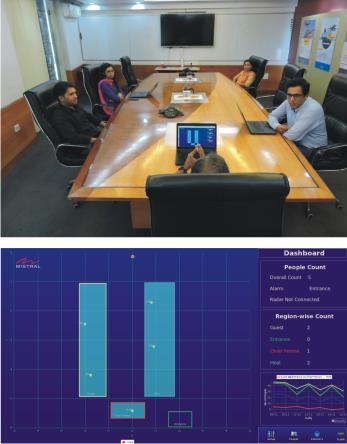 Here is a sample view of the people counting application UI for a meeting room that counts and displays the number of participants and location in real-time.
Here is a sample view of the people counting application UI for a meeting room that counts and displays the number of participants and location in real-time.
The RADAR data processing chain implements object detection, range and axial velocity computation, static clutter removal, grouping and tracking algorithms providing processed point cloud RADAR data for object identification and tracking.
DEMO ENVIRONMENT
- Radar: Mistral’s 60GHz AoPCB module
- Location: Meeting Room
- Dimension: 4mx6m
- Operating Field of View :120°
- People detection and tracking: every 250 milliseconds
- Region of interest: Host, Guest, Chairperson, Entrance
- POSE: Elevation 3m, 10 degree tilted down
CUSTOMIZATION
Mistral offers customization services for healthcare, security, industrial and other related applications. These include:
- Custom application development
- Integrate with other sensors (Sensor Fusion)
- ML/DL based movement prediction and posture
- Antenna customization for various use cases.
Webinar – An Insight into mmWave RADAR Technology and Product Design
Date: 19th & 20th November 2019
Millimetre-wave RADAR is an extremely valuable sensing technology ideal for the detection and providing information on range, velocity and angle of objects. mmWave RADAR is a trending technology especially in the Automotive & Industrial domain to enable intelligent and autonomous decision making at the edge! There is an immense need in the market for solutions to count, track and monitor people without compromising on their privacy. mmWave RADARs is ideally suited to address these needs. This webinar aims at providing a complete insight into mmWave RADAR based product design. Watch the webinar video below.
Get a Quote:
RESOURCES
-
Product Brief
77GHz Automotive mmWave Radar on Module
-
Product Brief
60GHz mmWave Technology based Industrial AoP Radar on Module
-
Product Brief
Sensor Fusion Kit based on millimeter wave RADAR
-
Infographics
Sensor Fusion for Vision Analytics
-
Infographics
Millimeter Wave Technology
-
Article
Vital Sign Monitoring using mmWave Radar
-
Blog
Automotive and Infotainment – An Overview
-
Demo Video
AM65x SoM and mmWave Radar based Motor Control Demo
-
Webinar
mmWave Technology Webinar
-
Demo Video
60GHz AoPCB Industrial Radar for people counting
-
Demo Video
Sensor Fusion Kit
-
Product Brief
60GHz AoPCB Radar
-
Application Note
Industrial Robotics Control Unit
-
Article
Designing a cost-effective UGV for security and surveillance






